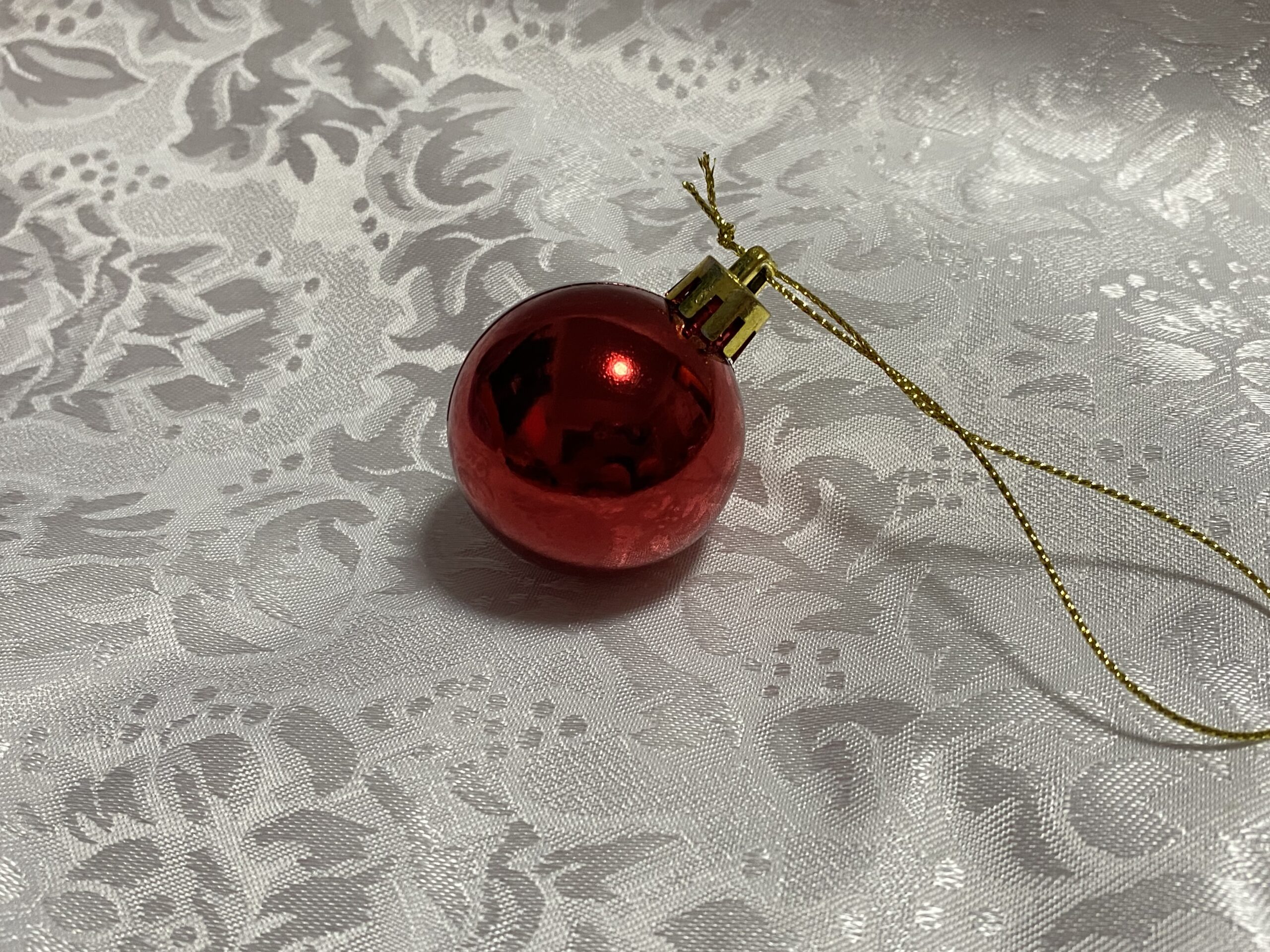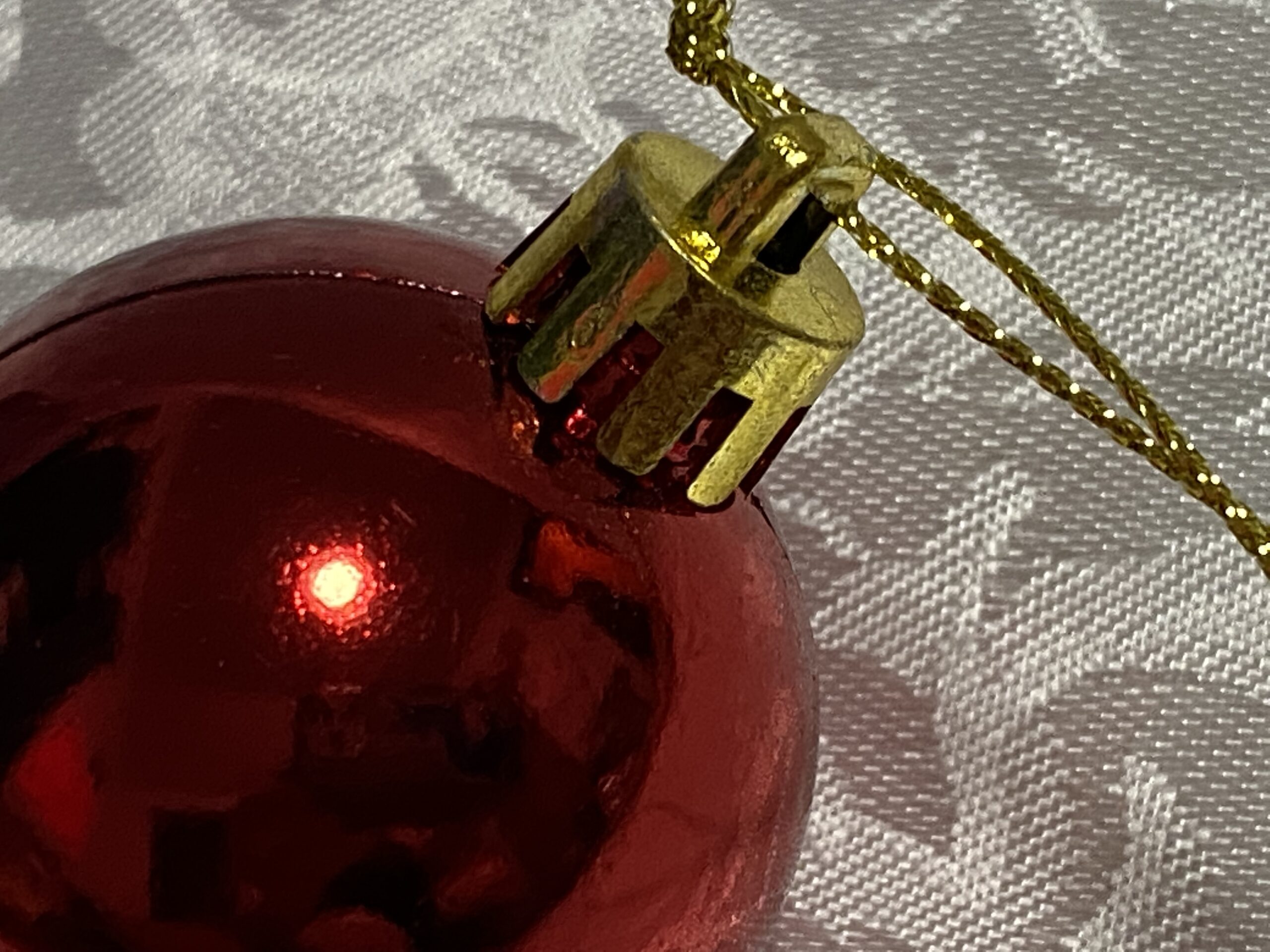Red Plastic (2020) Aldi Christmas Ornament Ball: Positive for Lead + Cadmium + Arsenic (51,700 ppm!!!) + Antimony!

For those new to the Lead Safe Mama website:
Tamara Rubin is a multiple-federal-award-winning independent advocate for childhood Lead poisoning prevention and consumer goods safety, and a documentary filmmaker. She is also a mother of Lead-poisoned children (two of her sons were acutely Lead-poisoned in 2005).
- Tamara owns and runs Lead Safe Mama, LLC — a community collaborative woman-owned small business for childhood Lead poisoning prevention and consumer goods safety.
- Since 2009, Tamara has been using XRF technology (a scientific testing method) using the exact instrumentation employed by the U.S. Consumer Product Safety Commission to test consumer goods for toxicants (specifically heavy metals — including Lead, Cadmium, Mercury, Antimony, and Arsenic).
- Since July of 2022, the work of Lead Safe Mama, LLC has been responsible for 5 product recalls (FDA and CPSC).
- All test results reported on this website are science-based, accurate, and replicable.
- Items that Lead Safe Mama, LLC reports on are tested multiple times to confirm the results published (for each component tested).
- Tamara’s work was featured in Consumer Reports Magazine in February 2023 (March 2023 print edition) and The Guardian in November 2023.
This is an ad-free article.
We have removed advertisements from this article to make it easier for you to read. If you would like to support our independent consumer goods testing by contributing (which will also help us keep our more widely-read articles ad-free!), click here. Thank you!
Published: December 7, 2021
Updated: December 19, 2023
For more information about the concern for toxic heavy metals in this red plastic Christmas ornament please read this companion article – link.
XRF test results on the red plastic of the ball ornament pictured
60-Second XRF Reading
- Lead (Pb): 213 +/- 19 ppm
- Cadmium (Cd): 112 +/- 7 ppm
- Mercury (Hg): non-detect
- Bromine (Br): 17,800 +/- 200 ppm
- Chromium (Cr): 378 +/- 24 ppm
- Vanadium (V): 688 +/- 54 ppm
- Iron (Fe): 212 +/- 15 ppm
- Nickel (Ni): 52 +/- 8 ppm
- Copper (Cu): 21 +/- 7 ppm
- Zinc (Zn): 180 +/- 7 ppm
- Arsenic (As): 51,700 +/- 500 ppm
- Titanium (Ti): 1,799 +/- 92 ppm
- Tin (Sn): 71 +/- 9 ppm
- Antimony (Sb): 4,198 +/- 54 ppm
- No other metals detected in consumer goods mode.
Suggestions, Solutions & Safer Choices
Most articles on the Lead Safe Mama website also have links to suggestions for specific safer choices and / or more general guidelines for making safer (related) choices for your family. This includes this article (that you are reading right now) which has both guidelines for safer choices for Christmas decor as a whole – as well as a bit of a summary about which toxicants (which poisonous heavy metals specifically) can be found (using XRF technology) in which types of decor (to help give you an idea of what to avoid.)
Towards the bottom of this article specifically I have written a brief summary of ten easy suggestions / guidelines to follow with some simple fun ideas for making safer choices for your Christmas decor. I also invite you to visit my friend Carissa’s site CreativeGreenLiving.com, where she focuses on fun non-toxic projects you can do at home with your family (many of which are decor related!)
Here are some clickable “Christmas” category buttons to get you started in searching this website!
“Christmas” does not equal
“intended for use by kids.”
The most important thing to remember when decorating your home for the holidays is that most Christmas decor (and other holiday decor too!) is – from a manufacturing & regulatory perspective classified as “not intended for use by children”(!) This is true for both vintage and new items! [This means they are exempt from much (if not all) of the regulatory protections that limit toxicants in items classified as “intended for use by children”.]
Christmas items are not toys
While many Christmas items may LOOK like toys (or may look like something a child would play with – and are therefore very attractive to children) they are simply NOT toys.
- Painted items: Many Christmas decor items (including ornaments – especially wood, glass or metal ornaments, both antique or new) are painted with Lead-containing paint, or (if they are red) with high–Cadmium-content paint or glaze. Cadmium is a known carcinogen, you can read more about Cadmium on this link.
- Plastic: Plastics – including many ornaments that go on the tree (including plastic decorative ball ornaments) or other plastic electric items (specifically items that plug in – like a pre-lit artificial Christmas tree) are likely to either be high in Lead (which causes brain damage in young children) or to have high levels of Antimony (which is known to cause cancer in rats) – as one or both have been applied as flame retardants to these types of products.
- Metal: Pewter or other solid metal ornaments can be made with unsafe levels of Lead (as is true with most heavy shiny yellow Leaded brass) or unsafe levels of Antimony. Vintage or antique pewter items are generally very high Lead. Newer pewter items tend to be high in Antimony. Functional items made of pewter (like decorative serving trays or tea sets) should NEVER be considered safe for food use, BTW. Most pewter that is marked “Lead-free” still actually has unsafe levels of Lead — even if Lead is no longer a main constituent in the substrate of the item! [And in most cases, the bulk of the “missing” Lead in so-called “Lead-free” pewter has been replaced with Antimony — which can be just as toxic, if not more so!]
- Christmas Trees: Artificial Christmas trees are generally either high in Lead or high in Antimony as well. The California “Prop 65” warnings that come with many of these items are NOT a “CYA” (Cover Your Ass) warning “just put there by the manufacturer just to be safe”! They are legitimate warning labels — because these products legally contain toxic chemicals (mostly applied or integrated into the product to comply with flammability regulations.)
- Vintage Ceramics: Vintage ceramics designed for the holidays (especially vintage Christmas mugs) are not generally safe for food use and should NOT be given to children (like with hot cocoa) — unless they have specifically been tested and have been shown to be both Lead-free and non-leaching (of any toxic chemicals.)
- New Ceramics: New holiday ceramics can also be high-Lead (although they may or may not be leaching when new). In fact, many new Christmas ceramic items (like decorative trays and bowls and platters) actually may never have been leach-tested — because they are considered to be “decor” and not functional food use items (even though the practical application of these items may indeed be for food.)
- Twinkly lights: Plug-in holiday string lights generally have high levels of either Lead or Antimony in the cords and bulb holders. This goes for both new and vintage / older light strings as well as plug in trees and other plug in holiday decor items. Based on the testing I have done, older light strings are more likely to have unsafe levels of Lead and newer light strings are more likely to have high (potentially unsafe) levels of Antimony.
As a result, most Christmas items (including brand new Christmas china and ornaments) can LEGALLY have unsafe levels of XRF-detectable heavy metals including (but not limited to) Arsenic, Lead, Cadmium, Antimony, — and even Mercury!
“Tamara, what I am supposed to do about this? It seems like toxic chemicals are everywhere!” The answer is simple (and inexpensive too!) “Go Old-School!”
If you want to decorate your tree and home in a child-safe and nontoxic way, I recommend going “old-school.” For me, what this means is decorating in the way your grandparents or great grandparents may have decorated (before rabid consumerism and mass-manufactured products took over the holidays!)
Here are TEN simple steps you can take…
(things you may have time for because you are home with kids for the pandemic!)
- MAKE the decorations yourself!
- Decorate with fruit, flowers, pine cones and strings of popcorn,
- Decorate with drawings and ornaments made from scratch by your children.
- Sew fabric decorations (this is a great teaching opportunity for the kids!)
- Knit (or crochet!) some of your decorations!
- Use colorful ribbons and strings to decorate the tree.
- If you are hardcore environmentalist, you may also choose to use a reusable-potted plant instead of a cut-down (and later throw-away!) tree.
- Purchase safe ornaments. Some brands may have ornaments expressly designed for use by children — and they are usually marked to indicate that. (I know Hallmark carries child-safe ornaments. Modern – new ornaments from Disney are likely safe as well – as long as they are marked that they are intended to be used by children.)
- If you must use string lights, the battery operated fairy light style string lights tend to test negative for both Lead and Antimony (the main environmental consideration then becomes the batteries – and to address that concern, you can get some long-lasting rechargeable / reusable batteries!)
- Instead of using Christmas-themed decorative china – use your everyday dishes – and just make sure the food on the plates is festive. Who notices the china under a nice gingerbread man, anyway? — it’s the cookie that matters, not the dishes! Here’s a link to the (rather festive, but simple) dishes we use every day in our home.*
As always, thank you for being here. Thank you for reading and sharing Lead Safe Mama articles. Please let me know if you have any questions and I will do my best to answer them personally as soon as I have a moment!
Tamara Rubin
Owner – Lead Safe Mama, LLC
#LeadSafeMama
*Amazon links are affiliate links. If you purchase something after clicking on one of my links I may receive a small percentage of what you spend, at no extra cost to you.
Never Miss an Important Article Again!
Join our Email List
























